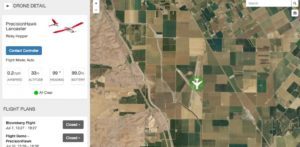
The LATAS system uses Digital Globe’s Geospatial Big Data (GBD) technology to allow drone operators to avoid obstacles such as buildings or cable lines, Harris’ flight-tracking data to allow coordination with existing flight plans, and Precision Hawk’s geo-fencing features to allow drones to effectively observe appropriate boundaries around airports and restricted areas. Verizon’s LTE networks provide the communications systems.
“LTE networks have the potential to allow drones to deliver sensor data for processing, analysis and decision-making mid-flight and to receive command-and-control inputs in real-time, resulting in a safer, more reliable shared airspace,” said David Famolari, Director, Verizon Ventures. “While much further study is required, this demonstration is an important step in advancing industry efforts to safely manage commercial UAV operations at scale.”
The LATAS system may offer a “safety as a service” product to consumer and commercial drone users. The system is now in testing at both the FAA and NASA, as part of the FAA Pathfinder and NASA Unmanned Aerial System Traffic Control Management (UTM) programs.
“With this collaboration, the innovation of the tech community is addressing the timely need for a safety services to accelerate drone integration,” said Tyler Collins, Director of LATAS at PrecisionHawk. “Verizon, Harris and DigitalGlobe bring technology components, expertise and credibility that are critical to the success of this ecosystem. We look forward to expanding testing through the FAA Pathfinder and NASA UTM programs in 2015.”

Miriam McNabb is the Editor-in-Chief of DRONELIFE and CEO of JobForDrones, a professional drone services marketplace, and a fascinated observer of the emerging drone industry and the regulatory environment for drones. Miriam has penned over 3,000 articles focused on the commercial drone space and is an international speaker and recognized figure in the industry. Miriam has a degree from the University of Chicago and over 20 years of experience in high tech sales and marketing for new technologies.
For drone industry consulting or writing, Email Miriam.
TWITTER:@spaldingbarker
Subscribe to DroneLife here.